I am a Niagara boy who has long had a little crush on the Hammer. Admittedly, it can be a bit of a weird place, but it is oozing with character. Since many a folk refer to the entire fruity, rusty peninsula as Hamilton-Niagara, you would think that these places – the one in which I grew up and the one I like to visit – are well-connected.
Not for transit riders, they’re not.
On our Ontario Bus Map 1.0, Niagara was connected to Hamilton by the thinnest of Megabus lines. As a reminder, our thinnest line was service at least once/week, but less than once/day. After cutting more frequent service a few years ago, Megabus’ Hamilton-Niagara service tied for first place for the “You probably do not even deserve a line” award: one trip in each direction per week. Recently I checked back at the Megabus schedule and could not even find that single weekly trip.
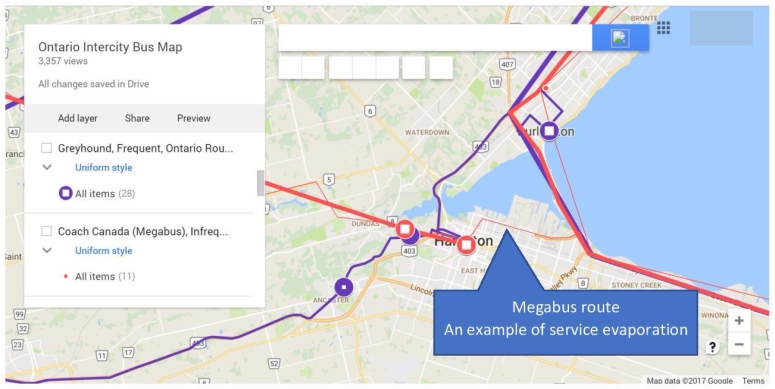
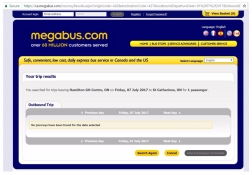
So now that Megabus has abdicated its utility, how could one get from Niagara to Hamilton?
Greyhound and VIA are not worth talking about here, but GO is. A while back I posted an article about the quizzical #12 bus. In the post-Megabus era, GO’s #12 bus is basically THE transit link for Hamilton-Niagara. Except that it doesn’t link.
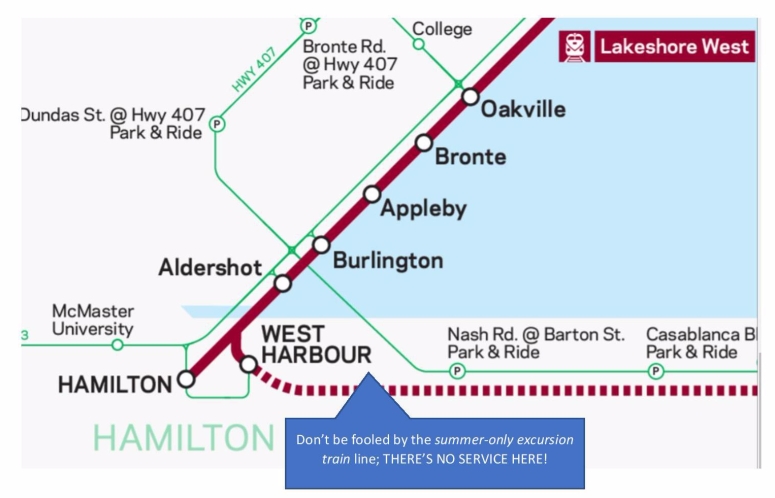
I should be straight up in saying that I recognize that the travel patterns around Hamilton make network planning complex. Although I am still looking for numbers, there is reason to believe that most people leaving Niagara on public transport are headed to the actually-not-hostile-to-transit areas in (or close to) Toronto. I get it that it makes more sense to run all buses over the short cut that is the Burlington Skyway. A good 98% of my trips follow that pattern and at those times, I love the Skyway.
But there’s a catch: the balance is only 2% because these days I rarely go to Hamilton because it’s hard to get to.
To lay this out, when traveling from the #12 bus (i.e., the lifeline to Niagara) to Hamilton, these are the options that I see:
Option A: 1. Alight (aka, “get off”) at Stoney Creek, 2. take a Hamilton city bus (HSR #2) downtown
Option B: 1. Alight at or before Burlington GO, 2. take Burlington Transit express bus downtown (BT #101)
Option C: 1. Alight at Burlington GO, 2. take the LSW GO train to Aldershot, and then 3. GO bus #18 to downtown
Option D: 1. Alight at “Dundas & 407”, 2. take GO bus #47 (407 West, local) to downtown
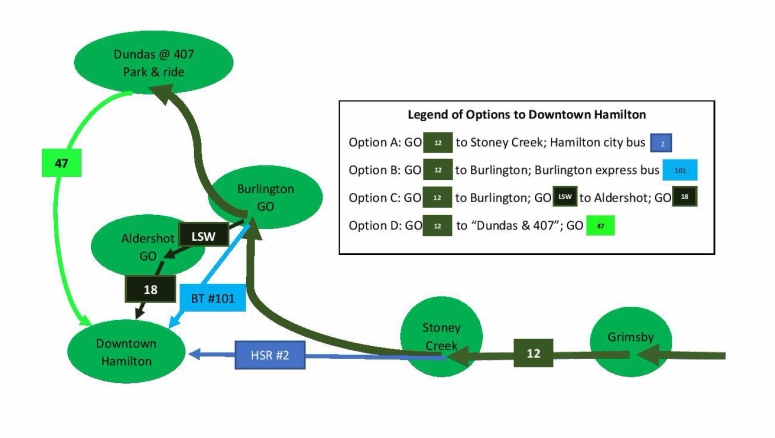
As you can see, none of these options are worthy of consideration as connectors of Hamilton-Niagara.
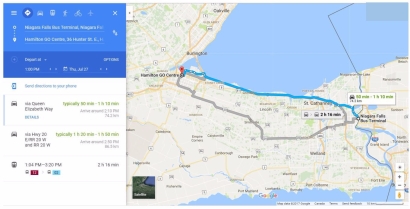

I know that I am not the only one who judges the effectiveness of transit service according to how well it competes with the automobile. In that sense, the current situation is one where transit is a big loser. Using Niagara Falls Bus terminal as the starting point (therefore eliminating the travel to the station and any waiting time), according to GoogleMaps, transit typically takes 2-3 times as long as driving.
But what about the train, won’t that help?
As much as I like to call Niagara’s non-sensical adoration of green trains, this is one case where the train actually will help since the tracks head through the new West Harbour Station on James Street in Hamilton. This being said, my fellow train-obsessed Niagarans need to be able to get their head around this trade-off: when
headed to Toronto, vehicles going through Hamilton lose the benefit of the Skyway short-cut. They will also stop a gazillion times between Niagara and Toronto, which they should, because the Toronto-bound ridership demand is far higher at the major stations in the GTA.
I realize that I have offered no solution in this post; don’t worry, it’s coming. As of today, in 2017, my point is merely this: GO’s operations in Niagara are predominantly buses, yet the agency has not figured out how to link a region of 431 000 people with an essentially neighbouring city of 330 000. I am by no means a transit planner, but I am sufficiently geeked out to know a few principles and bring forth a few points.
Stay tuned, those principles and points are up next
(Update August 16, 2017: the second installment on Hamilton-Niagara is now posted here).
Addendum – 1 August 2017:
My tweet to announce this blog post has generated some traction.
Most of this is discussion about how Route 12 might be modified for improved access.
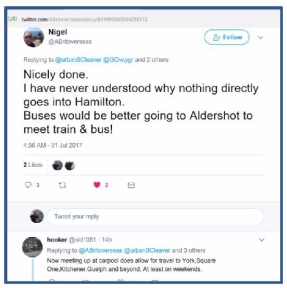
Some of it included facts that were news to me.
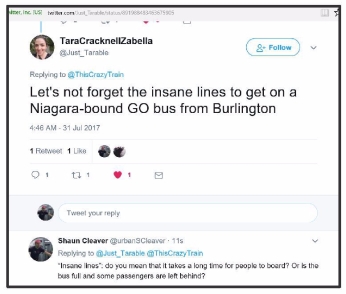
And some of it was predictable.
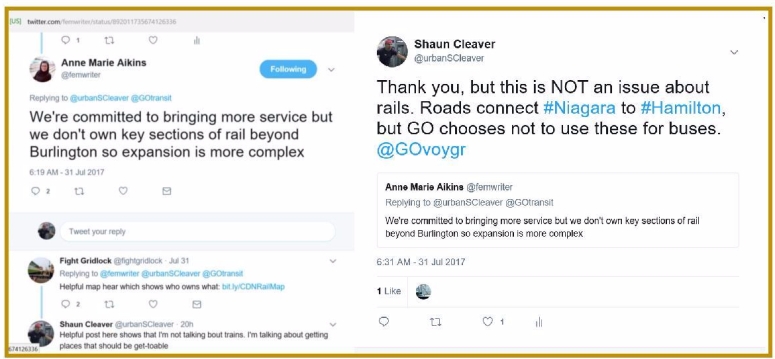
Thanks to all who care enough about this issue to discuss. By which I mean, contribute more than off-the-shelf answers of the “This is the way we do things because we do them this way” persuasion.

Planners for integrated Niagara Region Transit service, don’t seem to consider a link with Hamilton a worthy objective, nor do HSR planners seem to get that having some sort of connection t least to Grimsby would make a lot of sense. (Grimsby, more than any other Niagara-Region municipality, almost seems like an extension of east-end Hamilton / Stoney Creek.)
Hamilton proposes a rapid transit line to the area of Fifty Road and the Queen Elizabeth Way — but that’s as close as it gets to Niagara and that’s at least 20 years in the future.
The GO train line, when it’s up and running, will definitely help solve this, since only some GO trains will extend all the way to Toronto — many will start and end in West Harbour GO, I believe.
Historically, the transportation links between Hamilton and Niagara were much stronger. From the 1890s to 1930s, a radial railway extended from downtown Hamilton through Grimsby to Beamsville (and, briefly, Vineland.) More recently, frequent intercity buses operated by Canada Coach Lines served communities throughout the Niagara Region. And, for many years after 1960, the City of Hamilton owned Canada Coach, so had an interest in maintaining those links.
But, those days are long gone…. which, of course, part of the reason your blog exists in the first place!
LikeLiked by 1 person
The “Transit must be Trains” has negatively impacted Markham and Stouffville as well.
Up until June 24, the Stouffville GO Line had standard GO service. Inbound trains in the morning peak, Outbound trains in the afternoon. The rest of the day and on weekends the line was served by express busses which ran every 20-30 minutes. These busses, outside of rush hours, were quicker than trains as Stouffville line trains are unreasonably slow and the busses skip all stops form Union Station till Unionville Station in Markham. (At busy times they actually had 2 sets. Express till Unionville and local till Centennial and Express till Markham and local till the Lincolnville or Uxbridge). Then on June 24, GO switched midday and evening service to trains which are slower, run only once an hour, and only run till Unionville Station. Passengers travelling further North-East have to transfer to busses. So the service is slower, less frequent, and now requires a transfer. People have complained but to no avail: http://www.cbc.ca/news/canada/toronto/stouffline-line-schedule-changes-1.4230894.
Timetable + Map is available here: http://www.gotransit.com/timetables/en/PDF/Maps/06170917/Table71.pdf
Part of it to me seems like an ideological desire to replace busses with trains even if busses do a better job.
LikeLike
@Ali, thanks for weighing in.
From what I’ve seen you mention, there could be similarities and differences between the ideologies of Niagara and Markham. It seems that in Markham, the preference for running trains comes from Metrolinx. Meanwhile, there are informed transit riders who see the downsides of the trains – and enough of them to get CBC’s attention. Municipal politicians are even lobbying for buses.
What I am not seeing through this anecdote is the citizenry of Markham saying “if it’s not a train, we’re not interested.”
By contrast, Niagara politicians talk of “bringing GO to Niagara.” As if there’s not already hourly local service (12), and now a number of express services too (12B). I see this message working politically because it aligns with the popular perception in Niagara:
-driving to a GO station to ride a *train* to Toronto is a useful and dignified form of transit, while
-losers ride buses because they cannot (afford to) drive.
Although I agree that an inconsiderate love of trains *might* factor into both situations, I don’t see them as the same. In the case of the Stouffville corridor, I see the new schedule as a small corrective to a major flaw of GO’s design: its longstanding ignorance to travel needs within the 416. For too long, GO has acted like a shuttle service between Union Station and parking lots in the 905.
LikeLike
Hi Shaun,
Thanks for replying!
Municipal politicians acutally did not care until we the transit riders were able to convince the CBC to write a story on this issue. City Council and local media discussed the concern about train horns at night but not this concern. Many residents in Markham also only use the GO during peak periods and are therefore possibly not aware of how the old bus service was better. The way they advertised it contributed to that perception. Have a look their poster: https://www.facebook.com/GOtransitOfficial/photos/p.10155296191623444/10155296191623444/?type=3&comment_id=10155419596468444&ref=notif¬if_t=like¬if_id=1500475398010700
I do think you are right though about the difference. In Niagara it is citizens who feel that trains are intrinsically better than busses while in Markham and Stouffville it is GO Transit that is pushing a trains are better than busses narrative.
I also feel that there was politics behind it. The governing party can use the ‘we bought trains’ to Markham and Stouffville as part of their election campaign. Those not familiar with the corridor could easily think that there was no GO service outside of peak periods in the past, especially with the way GO has advertised the service changes.
As for GO being a shuttle service, I agree. GO should provide more service in the 416. However it should not neglect its loyal 905 service as a result. What GO should have done is added the trains to serve Scarborough and kept the express busses for Markham and Stouffville residents. Later on, if it is a better option, they should build an express local system similar to what the LSE/W lines have. I think the Mumbai model can work here. “Slow Trains” run as a surface subway till Unionville. “Fast Trains” make limited stops between Union and Unionville (i.e. Kennedy, Agincourt, Milliken) and make all stops north of Unionville.
LikeLike
Those are really good points. And I’m glad to hear that you’re not in the crowd of people who says, “People traveling within Toronto can go to hell – I pay a premium for GO, and all that matters is that service moves as quickly as possible from my point A to my point B.”
[Not that I thought you were, but I do hear people talk like that.]
With respect to this decision (and the timing) being a Liberal ploy, I suspect that you are right. Good on you guys for bringing out the negative aspects of this change. If seen only from the vantage point of minimizing operating expenses, hourly trains are probably “good.” I can get behind the idea of having occasional trains and more frequent express buses as long as the ridership justifies it.* In this case I cannot say if that’s the case. I also wonder where those buses would provide the most benefit to transit riders – maybe somewhere else in Markham-Stouffville? If the main goal of switching to less frequent trains is primarily to save money, and the buses are just pulled off the road, then I COMPLETELY agree with you. Given that transportation will be such a big issue in the upcoming provincial election, I wouldn’t be surprised if the Tories or the NDP pick up on the downsides of this change. My question to them, though, is what they would do instead. Given the obsession with trying to cut taxes by all parties, I don’t have high expectations from any of them – but I am open to being pleasantly surprised in the coming months.
*If you’re not familiar with it, check out the service from Hamilton GO Centre – there’s an example where there are different mixes of express and local train-connect buses, as well as a few trains. From my experience, all are pretty busy.
For the combination of express & local service, I’m mostly in agreement with you. I wish that GO did less “shuttle” and more “limited stop.” I think that the weekend train from Niagara Falls is actually a decent example of this, despite a few flaws; not only does it serve people traveling out in the periphery, but it also connects the most urban-oriented stations in each municipality.
LikeLike
Hi Shuan,
There is definitely ridership demand in the 905 for trains + busses. Not necessarily in the midday, but in the evenings for sure. If you look at the old schedules you will see something like this:
19:50 – Bus till Unionville & Centennial
20:00 – Bus till Markham through Lincolnville
20:10 – Bus till Unionville & Centennial
20:20 – Bus till Markham through Uxbridge.
The pattern will then phase to a 10-20-10-20 minute frequency with some occasional trippers to Unionville only as well.
As for 416 demand, as Vincent pointed out, there wasn’t service there at the time so demand there cannot be determined. And since GO does not release ridership counts or ridership studies one cannot determine if there was a demand basis for introducing the change. However, during peak periods, I would say that 40% of riders board the train at Unionville, 45% at stations north of Unionville, and 15% at 416 stations. However I would like to provide service in the 416 to build GO ridership, but not by inconveniencing existing loyal 905 riders. This is why having both trains and express busses is key.
GO did indicate that they reallocated busses elsewhere. So perhaps they have gone to route 12 for the temporary summer increase and will go to another route in September?
I’ve always felt the choice of stops for the Niagara train was odd. I didn’t understand why it stopped at Exhibition but not in Etobicoke and why it did not make a stop at Aldershot or in Hamilton. I never thought of it focusing stops in urban areas.
LikeLike
Paul Calandra, the PC candidate for Markham-Stouffville said that he will bring back express busses AND extend the all-day service to Lincolnville. Seems redundant but I’ll take it
LikeLike
“If you look at the old schedules you will see something like this [buses every 10 minutes in the evening].”
Since GO is pretty stingy with service, I take it at face value that the buses were well used. Was there an issue with pass-ups? Any idea to what magnitude?
“So perhaps [the buses have been reallocated] to route 12 for the temporary summer increase and will go to another route in September?”
Please let me know if you find out.
“Paul Calandra, the PC candidate for Markham-Stouffville said that he will bring back express busses AND extend the all-day service to Lincolnville.”
I am interested to see if the Ont PCs would entertain any serious plan to pay for this. This might be Markham-Stouffville’s equivalent to Scarborough’s electoral cry of “SUBWAYS!” -> a poorly-considered silver bullet presented in isolation from network and funding considerations. If Mr. Calandra really does mean this with any seriousness, he should be lobbying his party to increase the provincial tax base such that it can support that level of service on all corridors with similar ridership. Over to him to see if he really cares about how transit works, or if he’s instead picking a slogan that “proves” that he’s sticking up for Markham.
LikeLike
Hi Shaun,
It won’t let me directly reply to your comment below for some reason.
Busses were very well used. Outbound busses in the evenings did get full sometime forcing passengers to wait, This was usually after a sports game.
I disagree with your point on the Scarborough Subway. I believe the three stop extension to McCowan & Sheppard (and perhaps beyond) is needed. Major points of the subway network run through low density areas in rich and white Old Toronto and no one complains. But when immigrant heavy and lower income Scarborough wants a subway those in Old Toronto who have better transit complain about density and ridership (have a look at the crowd on Scarborough busses – a lot of people there cannot afford cars). It’s also not only about Scarborough. People are priced even further out. If Scarborough, which is one city in, won’t get a subway, how about the people who live in the Scarborough connected suburbs of Markham / Stouffville and Durham region ever get good quality transit. Scarborough is only good enough for an LRT, so those in Markham, aren’t even good enough for that. If we want a strong Scarborough Downtown it needs to be well connected via rapid transit to surrounding areas. An LRT is too slow and requires an extra transfer. While a one stop express is not the smartest idea, I rather have that and infill / extend it later than build an LRT and therefore abut subway construction in that area permanently.
I agree with you that Calandra seems disconnected on how transit works as running both the train and bus is redundant and the train cannot just be extended to Lincolnville as the line is single track so the same train will have to go up and come back down. Agincourt to Milliken is getting double tracked as we speak and there is a double track just north of 14th avenue. But nothing North of Unionville unless one counts the abandoned siding at Stouffville GO.
I do think large corporations need to pay more tax which should definitely be used to fund infrastructure. However, GO also needs to look at costs. They seem to run a really expensive operation with a money is no object mentality and they need to clean up their house. Use the savings to cut fares for riders.
LikeLike
Ali said: “…those in Old Toronto who have better transit complain about density and ridership…”
I rest my case about the proposed Line 2 extension in Scarborough: it is the prime example of transit tribalism, fabricated to create an “us vs. them” dynamic. Political gold. Public discourse disaster.
For a perspective from Scarborough transit riders about transit in Scarborough, see https://scarboroughtransitaction.ca/. I will cut and paste any further comments focusing on the subject to that website.
LikeLike
This is clearly not the best forum for discussing the SSE so I will not discuss it further. However I do want to speak on that webstite
It is the perspective of some Scarbarians, not all. Additionally it seems to have a lot of outside supporters whose source for information would be news media which is biased against the Scarborough Subway. The supporter I find most interesting is “De La Salle College “Oaklands””, an elite private school located in a low density and wealthy area in Old Toronto with subway access. The hypocrisy is disgusting
LikeLike
The service change to trains instead of buses inconveniences Markham and Stouffville but it seems made service better for Scarborough in that stations south of Unionville (Miliken, Agincourt and Kennedy) had no service at all outside of rush hour, probably because of their distance from the DVP……perhaps if GO had maintained the express buses in addition to the off peak trains to Unionville, it would have been better for both 905 and 416 travelers.
LikeLike
“….stations south of Unionville (Miliken, Agincourt and Kennedy) had no service at all outside of rush hour, probably because of their distance from the DVP.”
Ever noticed that none of the”all-day bus to complement rush hour-only train” routes serve the GO stations within the 416?
I have no faith that bypassing Scarborough was a matter of highway geography; it is completely consistent with GO’s longstanding approach of under-serving and over-charging trips within the 416. Fortunately, that trend is changing – albeit slowly.
LikeLike
I agree. GO should have maintained both busses and introduced the Trains. I do agree that 416 needs to be served but not at the expense of loyal 905 riders. Don’t sacrifice your current customer base to chase new ones. People in the 416 also have the TTC as an option while quality of local transit massively drops off north of Steeles.
LikeLike
Ali, I don’t disagree with you here. Comparing service on the 53 Steeles East and say….the parallel YRT Denison bus is like night and day. I know plenty of people in the 905, particularly Markham, who rely on GO in the off peak hours and who have been inconvenienced by the schedule change. If I’m not mistaken, GO RER service is never expected to exist north of Unionville. This is a massive missed opportunity as Markham station is located in a fairly walkable area. Unionville does have the connection with Viva but why end there? Very strange to me.
LikeLike
Hi Vincent,
I definitely agree regarding GO RER. I have no idea why they are ending it at Unionville. Unionville is located in an empty field by Highway 407 and surrounded by parking lots. While the area has a YMCA. Markham Pan-Am Centre, Bill Crothers Secondary, the future York U Markham campus, and future development – none of those are easily walkable from the station because of it’s design. It is designed as a park and ride. Even the Viva does not connect properly. Viva Pink, which is rush hour only west to Yonge and then South to Finch comes into the station. If one wants to go East (Viva Purple or Green) or travel off-peak (Viva Purple) one needs to walk a few hundred metres to Rivis Road and YMCA Boulevard. So transit connectivity isn’t great there either.
GO needs to reopen the historic Unionville Station so those living in Unionville can walk / bike/ ride till that station instead of driving down to the 407 and clogging up roads and parking. GO should extend RER to Mount Joy in my opinion. Most of Markham lives North and East of Unionville. RER will bring GO to the edge of town but forced people to drive till there causing more congestion and parking woes. Centennial Station (which should be called Markville) is a strong candidate for RER as it is located on the important McCowan road and has access to the relatively frequent (by YRT standards) 129A which connects to Scarborough Centre. Markham GO is walkable as you mentioned and Mount Joy will finish the set by providing a station in the new Northern subdivisions with enough parking for those driving from Stouffville. Mount Joy is also the last station within the continuous Toronto urban area making it the logical endpoint.
What I also don’t understand is why GO does not extended regular peak GO service to Goodwood and Uxbridge. It was part of MoveOntairo 2020 but taken off the books. GO busses already go there (unlike the Richmond Hill Extensions) so a ridership base already exists. Ridership does drop off but that is because service is a lot less. People would rather drive to Lincolnville for better service. Also already there are tracks and Uxbridge Station. Goodwood station is the only thing they need to rebuild. GO owns the tracks and no one uses them except for the York-Durham Heritage Railway on certain Weekends. Nothing is stopping them from transforming the Stouffville line to the Uxbridge line.
LikeLike
Sorry should be spelled “Milliken”
LikeLike